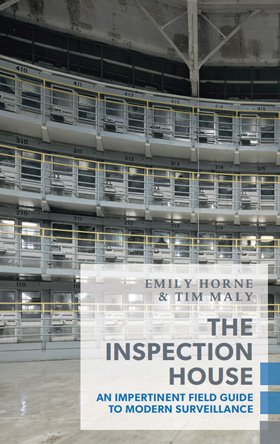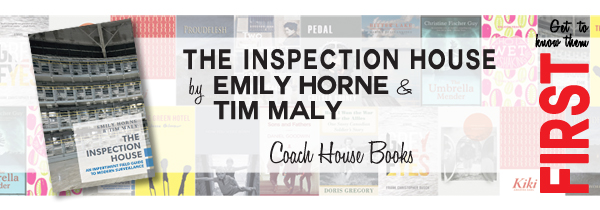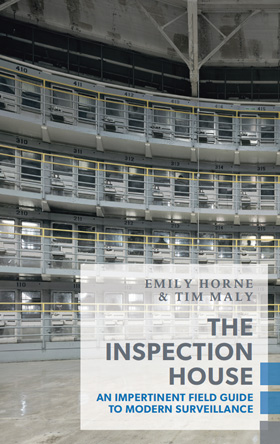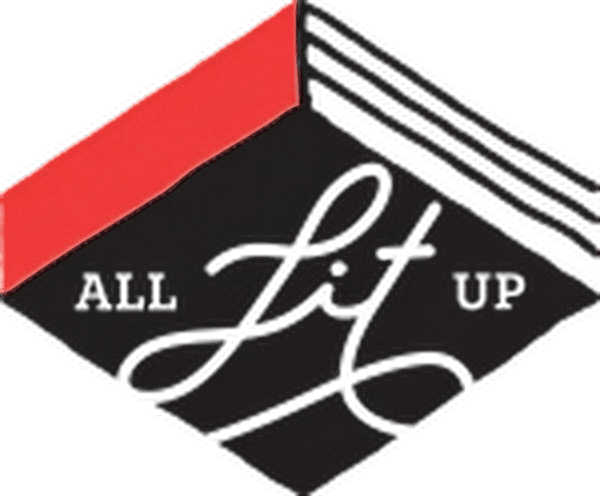Your cart is currently empty!
Get to Know Them First: The Inspection House by Emily Horne & Tim Maly
Our bookshelves continue to be filled with dystopian fantasies with titles like Children of Men and The Maze Runner. In some cases, the scenarios seem completely far-fetched (think The Hunger Games) while others don’t seem that far off (Big Brother is watching, right George Orwell?). But all these ideas had to come from somewhere. The Inspection House, published by Coach House Books, looks at modern surveillance, where it came from, and the many possibilities for tracking as well as resistance it offers.


The Book
In today’s hyper-connected world, most of us are probably aware that much of what we do is being tracked or surveilled but how exactly did we get to this point? In 1787, British philosopher and social reformer Jeremy Bentham came up with the panopticon, a ring of cells observed by a central watchtower, as a labor-saving device for those in authority. The French philosopher Michel Foucault took Bentham at his word. In his groundbreaking 1975 study, Discipline and Punish, the panopticon became a metaphor to describe the creeping effects of personalized surveillance as a means for ever-finer mechanisms of control.Back to today, the available tools of scrutiny, supervision, and discipline are far more capable and insidious than Foucault dreamed, and yet less effective than Bentham hoped. Think of all the places that are filled with surveillance possibilities: public squares, container ports, terrorist holding cells, and social networks. However, they are also rife with resistance and the possibility for revolution. The Inspection House: An Impertinent Field Guide to Modern Surveillance is a tour through several of these sites—from Guantánamo Bay to the Occupy Oakland camp and the authors’ own mobile devices—providing a stark, vivid portrait of our contemporary surveillance state and its opponents.The Authors
Emily Horne lives and works in Toronto, Ontario. She is the photographer and designer for the webcomic A Softer World, and freelance edits books for kicks. Her work has appeared in The Guardian, The Coast, and Tor.com.
We asked the authors of The Inspection House about a few of their firsts …
What was your first job? Was it anything close to writing?e: My first jobs were, collectively, products of growing up in a place – Prince Edward Island – known for tourism. So I sold red dirt-stained t-shirts on the boardwalk, or pretended to be an Acadian settler circa 1720, or slung lobsters (which, as a vegetarian, I was quite unqualified to recommend). You know, the usual.t: Not counting a paper route (kids: a paper route was a thing where you carried physical print outs of what you now know as news websites to people’s homes once a day), my first job was working at a family warehouse and industrial supply company in Newfoundland. They had cut a series of tubes to certain sizes and my job was to help fit the metal ends on them. This involved smearing Sunlight liquid soap all over the tubes as a lubricant and then holding the end steady while a winch pulled the tube into place. Later, I learned that the tubes were for the temporary sewage system on the Hybernia project.Was there something from the first draft of your book that got left out of the final book?e: The neatest thing we came up with that didn’t end up in the book was a game, actually. We discovered while reading the arguments for and against prison labour that they really haven’t changed much in the past, say, 300 years. So we pulled some quotes, and the reader was supposed to match them with the author and time period.t: Because of how we write, it is real hard to tell what the first draft began and end. Emily and I use shared writing tools that mean we are constantly writing and rewriting each others words. The game is the only thing we clearly cut, but lots of other stuff got shunted out or left behind.Was the final title your first title for your book? Share previous options here.e: We had all kinds of title ideas, and many of them were terrible. Our working title for a long time was #Foucault, a pretty bald-faced attempt to cash in on “hashtag culture” that would almost certainly be dated within months. I still like Visible and Unverifiable, which is one of the core concepts for Foucault’s understanding of the Panopticon. But The Inspection House was Jeremy Bentham’s subtitle when he first wrote about the Panoptic prison in 1791. It feels right!t: I just looked over one of our grant applications and as far as the Ontario Arts Council knows, we wrote a book called Surveil and Punish. OAC, if you are reading this, I will submit the name change in writing along side our final report.Do you have your outfit picked out for your first author event/launch?e: We did have a cool idea for this. One of the spaces we look at in the book is Oregon Corrections Enterprises. They produce, among other things, Prison Blues jeans. So Tim ordered a pair and thought he could wear them at events. Sadly, they’re too big, so we’re gonna have to come up with something else.t: I am still not sure that this was ever a cool idea.What is the first book you remember reading?e: This is definitely not the first, but one of the most vivid memories I have of reading as a kid was when my parents were reading Arthur Ransome’s Swallows and Amazons to me nightly. At a certain point it got so exciting that I had to take the book away and start greedily reading it on my own.t: In grade three I was falling behind in class and put in Resource because I wasn’t reading enough. My parents who were teachers fought hard to keep me in the regular class. My teacher that year used to read Gordon Korman’s Bruno and Boots books to the class and I loved them so much. I think Beware the Fish! was the first one I read myself. Thank you Gordon Korman.What is the first concert you went to? Would you see them again?e: The first concert I ever chose to go to myself was Weird Al Yankovic, in the early 1990s. When he finished his last song, we all started to get up and leave. A stagehand had to come out on the stage and explain that you’re supposed to keep clapping for an encore!t: Aerosmith. No.The Publisher
Tucked away on Toronto’s historic bpNichol Lane, Coach House Books has been publishing and printing high-quality innovative fiction and poetry since 1965. Coach House is one of Canada’s most venerable literary presses and has, during the past forty years, published books by Michael Ondaatje, George Bowering, bpNichol, Nicole Brossard, Christian Bök, Guy Maddin, Steve McCaffery, Gail Scott, Jonathan Goldstein, Anne Michaels, Michael Redhill and hundreds of others. A refuge for the refined, an asylum for the aesthete, a sanctuary for the scribe.*****Thank you to Emily and Tim as well as Coach House Books for giving us some further insight into The Inspection House. Catch up on all our Get to Know Them First books and authors here.



